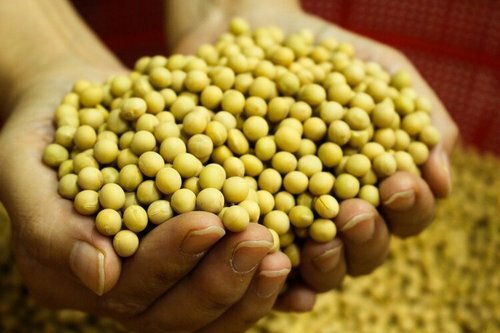MYTHS ABOUT SOY
By Living Springs Retreat Health Educator

SHOULD WE BE EATING SOY?
SOY...IN THAT??
Ever stop and think about how many grocery store food products contain soy? Soy is in a plethora of products in the super market such as chips, cookies, crackers, breads, snack nuts and seeds, salad dressings and pre-made desserts. Going beyond the supermarket, you will find soy or soy by-product in many of the menu items at your local fast food restaurant and even in restaurants that are not “fast food.” At your Sunday brunch at IHOP®, you will encounter soy of some varieties in the pancakes, French toast, egg dishes, all bread products and all the breakfast meats (bacon, ham, sausage).1 Yes, soy is a product that is often hidden away in the ingredients of many common foods. This article addresses soy and whether it is helpful or harmful to us.
THE SOURCE
The source of anything related to soy is of course, the soy bean. Soybeans are a type of legume eaten whole or processed to different varieties. The least-processed varieties include: whole soybeans, edamame (young and green soybeans), soy milk, and tofu. Soy milk is made by soaking and grinding whole soybeans, boiling them in water, and then filtering out the solids. After that process, you have a white liquid that is similar in appearance to dairy milk. Drinking soy milk is an alternative for people who do not wish to consume nut milks or dairy milk. Tofu is made using mature, white soybeans. The soybeans are soaked, crushed, and then mixed with water to form a slurry. The slurry is then strained into soymilk. Next, the soymilk is mixed with a coagulant such as nigiri, calcium sulfate, or glucono delta-lactone. Once the soymilk has been coagulated, curds form, much like the cheese-making process, which are then pressed into blocks. The longer it’s pressed, the firmer the resulting tofu texture.2 Although tofu is relatively tasteless, it can be prepared with seasonings, herbs, and other vegetables to make it taste very delicious. Tofu can be baked, scrambled, sautéed, fried, grilled, and steamed. It’s a very versatile food to vegetarians and vegans. Processed soy bean products include: yogurt, vegan and vegetarian meat substitutes, and soy cheeses. The packaged products include soy flours, texturized vegetarian protein, soybean oil, and soy sauce.
HISTORY
Soybeans originated in Southeast Asia, and were first domesticated by Chinese farmers around the year 1100 B.C. In 1851, soybean seeds were distributed to Illinois and the corn-belt states. This seed was a gift from a crew member rescued from a Japanese fishing boat in the Pacific Ocean in 1850. By the 1870's soybeans were gaining popularity, particularly with farmers for feeding their livestock. In 1904, the famous American chemist, George Washington Carver, discovered that soybeans are a valuable source of protein and oil. He also realized the benefits of soybeans for preserving good quality soil. In the 1940's soybean farming increased in the United States.4 To date, soybeans are mainly grown in Asia and in North and South America.5
“Most people, when they think about soy, don’t realize the astounding fact that the soybean has the most potent anticancer properties of any plant on earth.”
AMAZING BENEFITS
Most people, when they think about soy, don't realize the astounding fact that the soybean has the most potent anticancer properties of any plant on earth.6 Soybeans are very nutritious, containing two times the amount of protein than other beans. Three and one-half ounces (100 grams), of boiled soybeans will provide 173 calories, 16.6 grams protein, 9.9 grams of carbohydrates, 3 grams of sugar, 6 grams of fiber, and 9 grams of fat. The types of fat found in soybeans include monounsaturated, polyunsaturated, and omega-3, and omega-6. Concerning vitamins and minerals, soybeans contain Vitamin K1, Copper, Manganese, Phosphorus, Thiamine, some Niacin, Vitamin B6, and Pantothenic Acid. The Bioactive plant compounds include: Isoflavones, Phytic Acid, and Saponins. Isoflavones are unique phytonutrients that resemble the female sex hormone called Estrogen. So, Isoflavones are a plant estrogen. The three main types of Isoflavones found in soybeans include: Genistein, Daidzein, and Glycitein.7 Genistein is an anti-cancer agent and can decrease the ability of tumor breakout.8 In addition to all of these benefits, the soy bean has an alkalizing affect on the body.9 Our bodies thrive when we eat a majority of our foods that provide an alkalizing effect on our bodies.
DISEASE PREVENTION AND SOYBEANS
Isoflavones, found in soybeans, are compounds responsible for cancer prevention. A number of soybean compounds - including isoflavones and lunasin - may be responsible for the potential cancer prevention effects. Studies have shown they reduce breast cancer risk. They also have a protective effect against prostate cancer in men. Exposure to Isoflavones early in life may be protective against breast cancer later in life.10 Concerning osteoporosis, consuming soybeans reduces the risk, especially in post-menopausal women.
Many women suffer from menopausal symptoms. The good news is that studies show that consuming soy beans may actually help. Asian women, especially Japanese women, are less likely to experience menopause symptoms than Western women. Dietary habits, such as the higher consumption of soy foods in Asia, may explain this difference. Studies indicate that isoflavones, a family of phytoestrogens found in soybeans, may alleviate these symptoms.
SELECTION
In Western countries today, such as in the U.S., soy products are refined and processed, verses in Asian countries where the soybean is served whole. It is indeed, possible, however to find whole soy beans and varieties online and in markets with a wide varieties of foods. The healthiest version of the soybean is when it is organically grown, not genetically-modified, and in its whole state.12 When shopping in the grocery store, look for the label that says “Non-GMO”. Purchasing organic tofu, for example, ensures that the soybeans were not produced using harmful chemicals and genetically modified organisms. Soy is one of the top three crops in the United States that is genetically modified.13 It is crucial that we be smart shoppers and purchase soybeans or any soy product or item that contains soy by-product in it that is “USDA Organic” and/or “Non-GMO.” Genetically modified foods are exposed to a host of hazardous chemicals.
THE CONTROVERSY
Among some, the soybean is classified as taboo. The first genetically modified soybeans were planted in the United States in 1996. Since then, it’s been found that genetically modified soybean consumption can be associated with major health problems. The soybean of the Orient, consumed by many Asian people for hundreds of years prior to it coming to the west, gave no adverse health effects. So, this dynamic reveals that the manner in which soybeans are raised and produced is a major contributing factor to whether they will be healthful or harmful to us. When organically grown and without any of the unnatural farming techniques that are utilized today, the soy bean is a gem. Allergies only began appearing after it had been genetically modified. Imported GMO soy can be found as an ingredient in a WIDE range of foods, such as chocolate, potato chips, margarine, mayonnaise, biscuits, breads, and more.14 A non-organic processed food such as an energy bar, candy bar, or cracker that contains soy-based products in its list of ingredients, such as “soy lecithin” is most likely GMO soybean derived. If the candy bar or product is not organic, its most likely genetically modified. It is very important to read the ingredients carefully on any processed foods that you buy at the super market. A wise man once wrote, “get wisdom, get understanding...”“...neither soy foods nor soy isoflavone supplements alter measures of testosterone in men. Men and women can enjoy the benefits of organic Non-GMO soybeans!”
AT EASE YET WITH SOY?
Despite the health benefits, some men stay clear of soy because of the phytoestrogens. They fear that these naturally occurring estrogens would interfere with the production of testosterone. Research does not support this claim. An extensive review study indicated that neither soy foods nor soy isoflavone supplements alter measures of testosterone in men.”16 Men and women can enjoy the benefits of organic Non-GMO soybeans!
CONCLUSION
We have to take a good look at what we are eating. Science shows us that what we eat eventually becomes “who we are.” In other words, from a cellular level standpoint, you are what you eat. Do you want to live a long, healthy life? Eating a diet that is plenteous in organic, whole food plants is highly recommended for optimal health. Looking for some recipes? Check out Living Springs Retreat Recipes. You will find some amazing-tasting recipes that use organic soy, as well as other delicious plant-based ingredients! Here's to your health!
1 https://www.huffingtonpost.ca/hypefoodie/the-top-10-foods-you-didn_b_8214660.html
2 https://www.organicauthority.com/organic-food-recipes/how-to-cook-tofu-x-different-ways-like-a-chef
3 https://www.healthline.com/nutrition/foods/soybeans
4 https://ncsoy.org/media-resources/history-of-soybeans/
5 https://www.healthline.com/nutrition/foods/soybeans
6 Barbara O'Neill, Self Heal By Design, p.81
7 https://www.healthline.com/nutrition/foods/soybeans#vitamins-and-minerals
8 www.HealthIsLife.org
9 Barbara O'Neill, Self Heal By Design, p. 87
10 https://www.healthline.com/nutrition/foods/soybeans#benefits
11 https://www.healthline.com/nutrition/foods/soybeans#benefits
12 Barbara O'Neill, Self Heal By Design, p. 81
13 https://www.organicauthority.com/organic-food-recipes/how-to-cook-tofu-x-different-ways-like-a-chef
14 Barbara O'Neill, Self Heal By Design, p. 81
15 Proverbs 4:7
16 https://www.healthline.com/nutrition/soy-protein-good-or-bad#drawbacks





